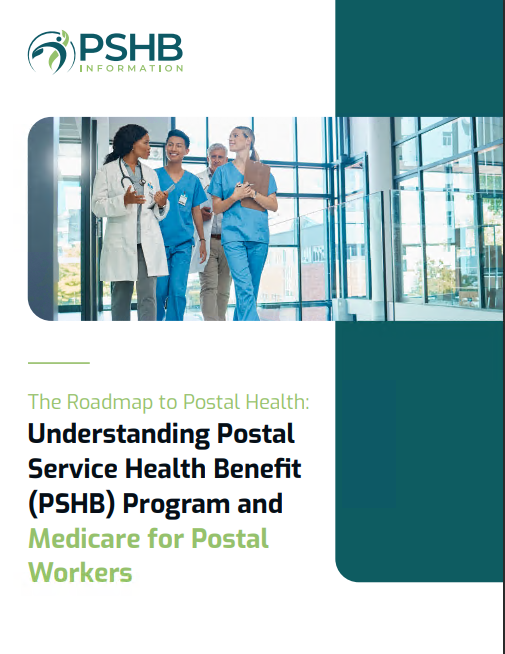Key Takeaways
-
Copayments can seem small at first, but they accumulate over time, affecting your overall healthcare costs. Understanding how they work helps you make informed choices when selecting a PSHB plan.
-
Certain plans offer lower copays for specific services, but you need to weigh these against premiums, deductibles, and out-of-pocket limits to ensure you’re getting the best value.
How Copayments Affect Your Healthcare Budget
When choosing a Postal Service Health Benefits (PSHB) plan, one of the most important cost factors to consider is copayments. While they might not seem like a major expense on their own, these fixed amounts you pay for medical services can add up significantly over time. A single $30 copay for a doctor’s visit may not be a concern, but if you have frequent appointments, specialist visits, or prescription medications, these expenses can take a noticeable bite out of your budget. Over the course of a year or more, these costs can impact your overall financial planning, especially if your medical needs increase with age or chronic conditions.
Additionally, unexpected health issues can drive up your annual medical expenses. A few unplanned emergency room visits or specialist consultations could push your costs much higher than anticipated. That’s why carefully assessing copayments is crucial when choosing a plan.
Understanding Copayments: The Basics
A copayment is a fixed amount you pay out-of-pocket for a covered healthcare service. It differs from coinsurance, which is a percentage of the total cost. Copayments vary by service and plan but are typically structured as follows:
-
Primary care visits: Usually lower, making routine check-ups more affordable.
-
Specialist visits: Higher than primary care copays, reflecting the increased cost of specialized care.
-
Urgent care and emergency room visits: Emergency services often come with higher copayments.
-
Prescription drugs: Tiered copayments depending on whether the medication is generic, brand-name, or specialty.
-
Hospital admissions: Some plans charge a fixed copay per hospital stay, while others require coinsurance.
-
Outpatient procedures: Depending on the type of procedure, copayments can vary significantly.
-
Mental health services: Therapy and psychiatric visits may have different copayments compared to physical health services.
Understanding these categories helps you estimate your annual healthcare expenses and plan accordingly.
The Long-Term Impact of Copayments on Your Finances
Even if individual copayments seem manageable, their cumulative effect over time can be substantial. Here’s what you should keep in mind:
-
Annual doctor visits and check-ups: If you see a primary care doctor four times a year with a $30 copay, that’s $120 annually.
-
Specialist appointments: A $50 copay for specialists can add up quickly if you need regular follow-ups.
-
Medications: If you take multiple prescriptions, monthly copayments can make a big difference in yearly costs.
-
Emergency care: A single emergency room visit could have a copay of $150 or more, adding to unexpected medical expenses.
-
Chronic illness management: If you require ongoing treatment, lab tests, and specialist visits, these costs can escalate over time.
-
Physical therapy or rehabilitation: Long-term therapy sessions can result in multiple copayments each month.
Comparing Copayments Across PSHB Plans
Different PSHB plans come with varying copayment structures. When evaluating plans, consider:
-
How often you need care: If you visit doctors frequently, a plan with lower copays might be more beneficial, even if the premiums are slightly higher.
-
Specialist access: If you require specialized medical care, check how much you’ll be paying per visit.
-
Prescription needs: If you rely on multiple medications, look at copay amounts for each drug tier.
-
Hospital and urgent care coverage: Review copayments for emergency room and urgent care visits, especially if you have a history of unexpected medical needs.
-
Outpatient services and therapy: If you need physical therapy or other recurring treatments, check the per-visit copayment requirements.
-
Preventive care coverage: Some plans cover preventive care services with little to no copayments, which can help reduce overall expenses.
Strategies to Manage Copayment Costs
While copayments are a necessary part of healthcare, there are ways to minimize their financial impact:
-
Use in-network providers: Out-of-network visits often come with higher copayments or additional out-of-pocket costs.
-
Choose preventive care when possible: Many PSHB plans cover preventive services at no additional cost.
-
Opt for generic medications: Lower copayments for generics can save significant amounts on prescriptions.
-
Explore telehealth options: Some plans offer lower copayments for virtual visits, which can be a convenient and cost-effective alternative.
-
Check for cost-sharing benefits: If you are enrolled in Medicare Part B, some PSHB plans may lower or waive certain copayments.
-
Consider mail-order prescriptions: Some plans provide cost savings when ordering a 90-day supply of medication.
-
Combine appointments when possible: Scheduling multiple services in a single visit can reduce copayments for separate consultations.
Hidden Copay Costs You Should Watch For
Not all copayments are straightforward, and some hidden costs can catch you off guard:
-
Multiple copays in one visit: Some appointments may involve both a specialist consultation and lab work, leading to separate copayments.
-
Out-of-network care: If you unintentionally visit an out-of-network provider, you may face higher copayments or even full charges.
-
Tiered prescription drug pricing: A medication covered under one plan’s lower tier might have a higher copay in another plan.
-
Urgent care vs. ER visits: A minor issue that could be treated at urgent care may cost significantly more if you go to an emergency room.
-
Ambulance services: Some plans charge a fixed copayment for ambulance transportation, while others may require coinsurance.
-
Specialty medications: Some high-cost medications come with separate cost-sharing requirements beyond regular prescription copayments.
-
Lab tests and imaging: Some diagnostic procedures have different copayment rates depending on whether they are performed in a hospital or an independent facility.
Choosing the Right Plan: Balancing Copayments with Other Costs
When selecting a PSHB plan, copayments are just one part of the bigger picture. You also need to consider:
-
Premiums: A lower monthly premium might mean higher copayments per visit.
-
Deductibles: If your plan has a high deductible, you may have to pay the full cost of care until it is met, in addition to copayments.
-
Out-of-pocket maximums: Once you hit this limit, the plan covers 100% of covered services.
-
Medicare integration: If you’re a retired postal worker with Medicare, check how your PSHB plan coordinates with it to reduce costs.
-
Service limitations: Some plans require referrals or prior authorization for specialist visits, impacting accessibility.
-
Copay exemptions: Some plans waive copayments for chronic disease management programs or wellness initiatives.
Your Next Steps for Smarter Healthcare Spending
Understanding how copayments accumulate over time can help you make the best choices for your healthcare budget. When evaluating PSHB plans, be sure to balance copayments with premiums, deductibles, and other out-of-pocket costs to find the right fit for your needs. If you’re unsure about which plan works best for you, reach out to a licensed agent listed on this website for professional advice.








